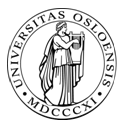

 |
Laboratory for Microbial Dynamics (LaMDa) |  |
|
LaMDa News Research projects |
Bacillus project: Current research topicsFrameworkB. cereus is a Gram−positive endospore−forming rod−shaped bacterium that is a major cause of food−borne infections due to its production of an emetic toxin or one or more enterotoxins. In addition it is an opportunistic pathogen particularly associated with nosocomial and serious eye infections. It is closely related to the highly pathogenic B. anthracis, the etiological agent of anthrax in mammals including man (16S rRNA sequences are for some strains identical), and to the insecticidal biocontrol agent B. thuringiensis. The toxin genes conferring the species−specific pathogenicity profiles of B. thuringiensis and B. anthracis are largely plasmid borne. The three species thus share a common chromosomal genetic background. In our research group we have for the last decade been studying the genetic relationship between these closely related bacteria, as well as different factors involved in pathogenicity. Current research topicsA. Comparative genomics. Main efforts include:
B. Phylogenetics and Typing. A robust multilocus sequence typing (MLST) scheme (based on partial sequencing of 7 housekeeping chromosomal genes) has been developed for B. cereus group bacteria, and has been used to map more than 180 strains, to increase our understanding of the phylogeny and population structure of the B. cereus group of organisms (collaborations with The Norwegian Institute for Public Health and Institute of Oral Biology, University of Oslo, and Institut Pasteur, France). An MLST website has been set up locally at the University of Oslo including three databases: (1) a database devoted to our MLST scheme, (2) an integrative supertree database combining data from four other published MLST schemes totalling ~1400 B. cereus group isolates, as well as (3) a supertree database combining MLST data with data from two other typing methods, MultiLocus Enzyme Electrophoresis (MLEE) and Amplified Fragment Length Polymorphism (AFLP), totalling 1850 B. cereus group isolates. C. Transcriptome analysis. The group has recently established microarray technology for gene expression studies in B. cereus group organisms, and is currently performing the first study of virulence factor expression. Analyses of resistance to bile salts are also conducted. Furthermore, in vitro infection studies are conducted using the human CaCo−2 intestinal cell line, in order to study gene expression in the bacteria and host during infection. D. Mobile introns. Comparative sequence analysis and functional characterization of group II introns (mobile RNA elements) and group I IStrons (composite mobile elements consisting of a group I intron and an insertion sequence (IS) element). This includes extensive in vivo and in vitro splicing experiments, mobility assays, and computational secondary structure predictions and comparisons. E. Multidrug transporters. Functional and structural characterization of conserved putative multidrug resistance transporters (MDRs). This project includes the creation of knockouts of selected MDR genes, expression analysis of knockout and wildtype strains using DNA microarrays, as well as crystallization and 3D protein structure determination using X-ray crystallography (collaboration with several partners including the University of Leeds, UK and The Institute for Genomic Research [TIGR] / J. Craig Venter Institute [JCVI], USA). F. Biofilm. The formation of biofilms, in which bacterial cells are embedded in a complex multicellular matrix, has important implications for drug resistance, pathogenicity, and ecology of microbial communities. The aim of this project is to identify and analyze the genes and factors involved in biofilm formation in the B. cereus group. This includes screening of a large number of B. cereus group strains for biofilm formation, in silico comparative sequence analysis, creation of gene knockouts, microarray expression analysis, and examination of cell surface structure by Atomic Force Microscopy. G. Gene function analysis. Some genes are selected for further studies, and gene knockouts are under construction. Examples include putative cell surface proteins, a gene cluster putatively encoding an antibacterial agent, DNA repair enzyme genes (AlkA−like), and a Type III DNA Restriction and Modification system. For additional data on collaborators, a full publication list, presentations, public and media communications, please see other links from the left−hand toolbar. |